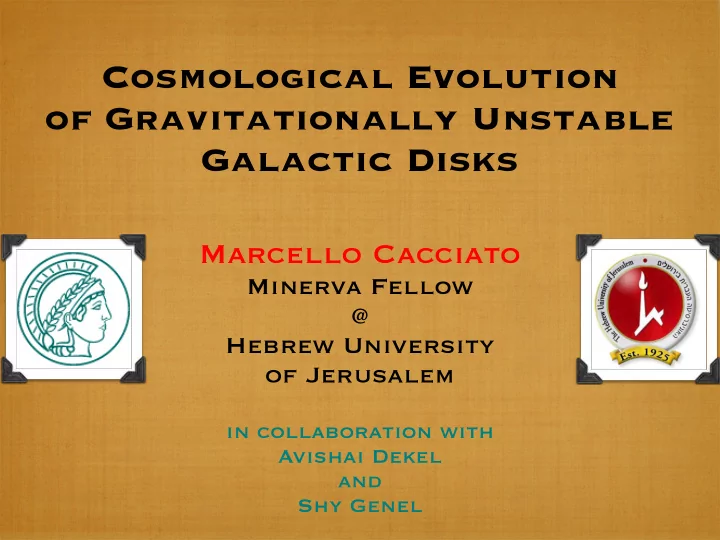

Cosmological Evolution of Gravitationally Unstable Galactic Disks Marcello Cacciato Minerva Fellow @ Hebrew University of Jerusalem in collaboration with Avishai Dekel and Shy Genel
Observed Disk Galaxies @ z~2 Disks rotating with V~200 km/s and ~50 km/s σ Several giant clumps of 10 9 M ⊙ ~1kpc size and M~ Star formation rates ~ 100 M ⊙ /yr mainly occurring in the clumps Genzel et al. (2006, SINFONI), Forster-Schreiber et al. (2006, SINS), Elmegreen & Elmegreen (2005, UDF), Elmegreen et al. (2007, UDF)
Theoretical studies and hydrodynamical cosmological simulations have shown that galaxies in dark matter haloes 10 12 M ⊙ of M~ at z~2 are typically Stream-Fed-Galaxies. 100 kpc Dekel, Sari & Ceverino (DSC 2009) propose a scenario where the evolution of Stream-Fed-Galaxies is driven by cold streams, disk instability and the growth of a central spheroid. * e.g. Dekel & Birnboim (2006), Keres et al. (2005)
The General idea Cosmological accretion V circ Migration inwards Σ R disk Self-Regulated Marginally Unstable Disk
Self-Regulated Marginal Instability high Surface Density: fragmentation and Migration Stable disk κσ accumulates disk “heats up” Q = π G Σ = 1 mass High Velocity Dispersion makes disk stable: Disk stops fragmentation and migration
Analytical Model Mass Conservation M gas , disk ≃ γ gas , acc ˙ ˙ M acc − ˙ M gas , inflow − (1 + γ fdbk ) ˙ M SFR M star , disk ≃ ˙ ˙ M star , acc − ˙ M star , inflow + ˙ M SFR Energy Conservation E int , disk ≃ ˙ ˙ M disk , inflow V 2 circ − ˙ E gas , dis Energy source: mass inflow in the potential well Gravitational Heating of the stars Gas dissipates in a dissipation timescale t dis ≡ γ dis t dyn Marginally unstable (Gas+Stars) Disk: Q − 1 2c = W 1 Q − 1 + W 2 Q − 1 gas = 1 where W i = f i ( σ gas , σ ⋆ , Σ gas , Σ ⋆ ) ⋆ Krumholz & Burkert (2010), Jog & Solomon (1984), Rafikov (2001), Romeo & Wiegert (2011)
Cosmological Evolution Solve the System of differential equations at current cosmological time (4 unknowns: ) σ gas , σ ⋆ , Σ gas , Σ ⋆ σ gas > c s ≈ 10km / s If Solution has then Update Values and Move to Step else Marginal Instability cannot be satisfied: Disk is labeled stable, evolution stopped.
1-Component: Disk always unstable δ disk ≡ M disk ∼ const M tot decreases with time Σ due to the way radius and Mass evolve has a maximum at z~1 σ because σ ∝ V circ ≈ V vir Disk unstable at z=0
Two Components initially unstable disks stabilize at later time (z stab ~0.5) ~40% of baryonic mass in the disk Red = Stars Blue = Gas Stellar Dominated Disks @ z stab Net Gas Cooling & Net Stellar Heating
The Role of Dissipation z stab weakly affected Dissipation Directly Related To Disk Depletion Gas Velocity Dispersion History affected
The Role of Outflows Outflows imply: Less Gas in the Disk + Less Star Formation = Less Massive Disks Lower Gas Velocity Dispersion z stab affected
Conclusions Analytical Model to follow the cosmological evolution of gravitationally unstable disks “Violent” Disk Instability in high z galaxies is a robust prediction initially unstable disks stabilize by z~0.5 due to higher stellar mass fractions (~0.8) due to “dynamically hot” stars ( σ star ∼ 8 σ gas ) due to disk depletion <---> gas dissipation
Future Perspectives Model improvements scatter in mass accretion: analytical merger trees metallicity-dependence <--->mass dependence Comparison with Hydro-Simulations (HydroART) [in collaboration with D. Ceverino] what sets gravitational instability? How/why does the instability fade off? what about alternate phases of stability and instability?
Thanks
Recommend
More recommend